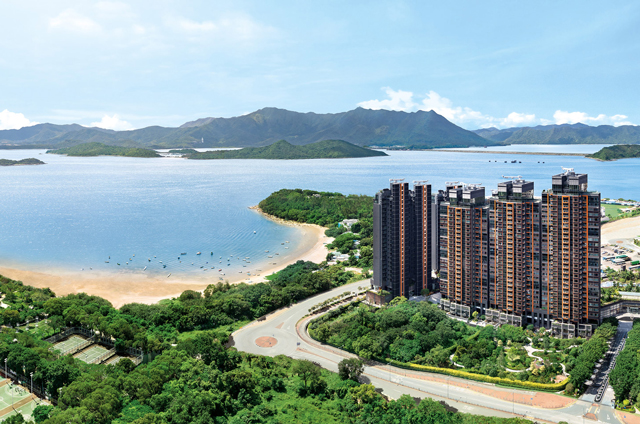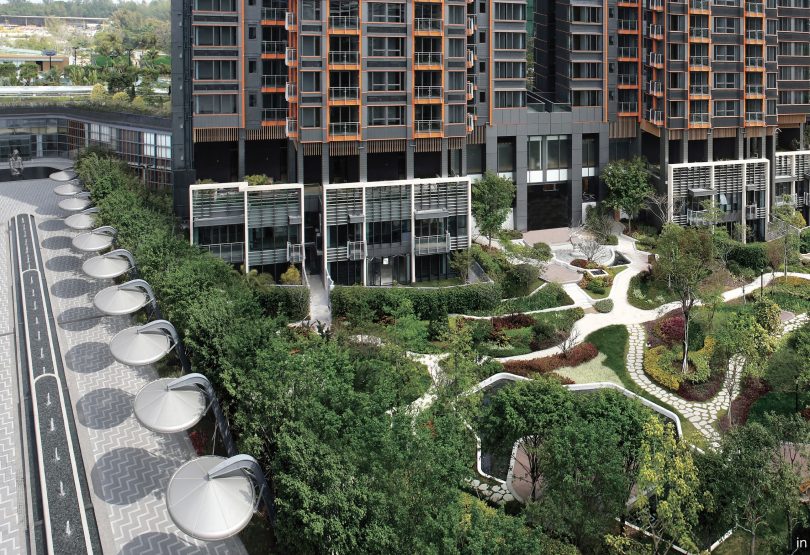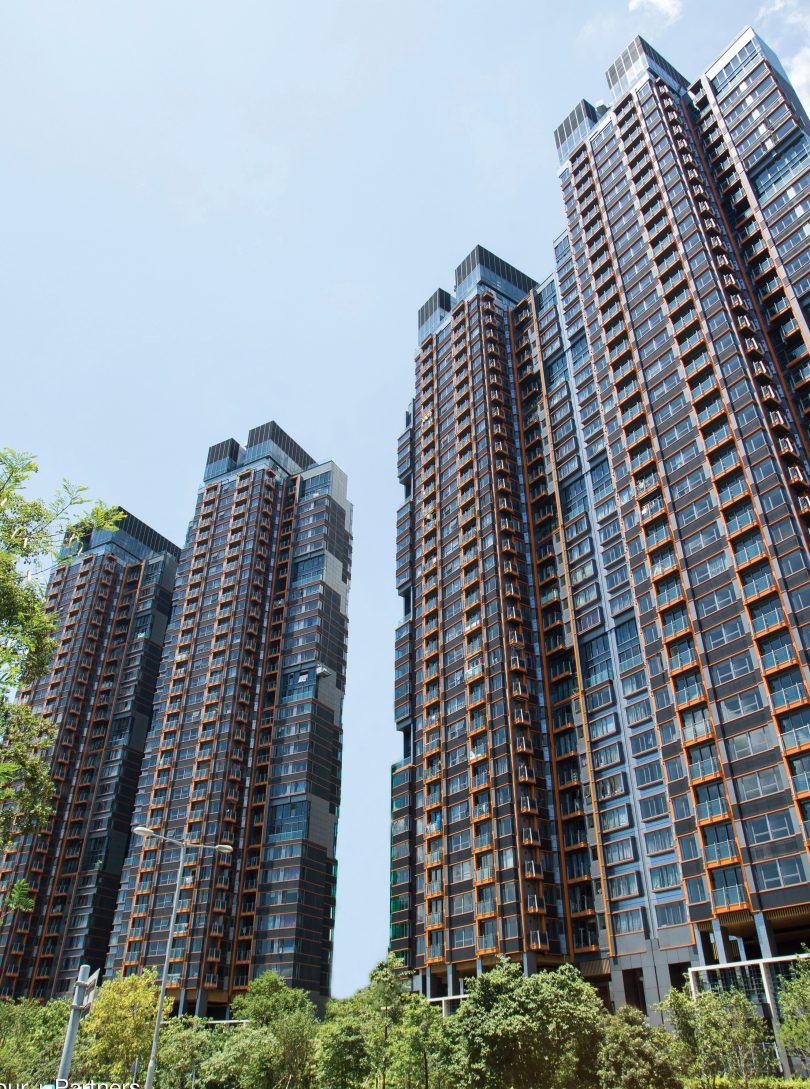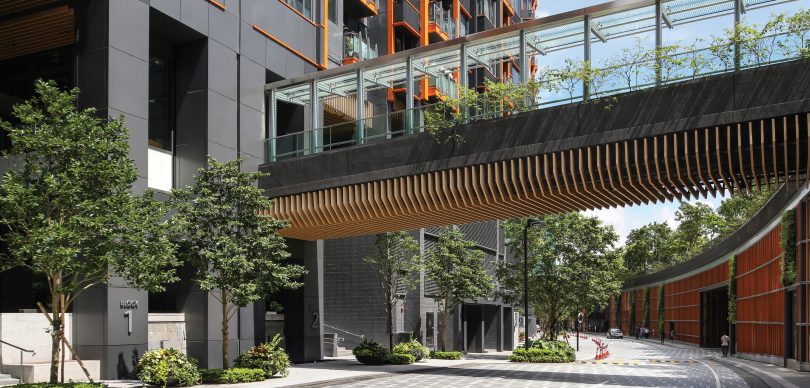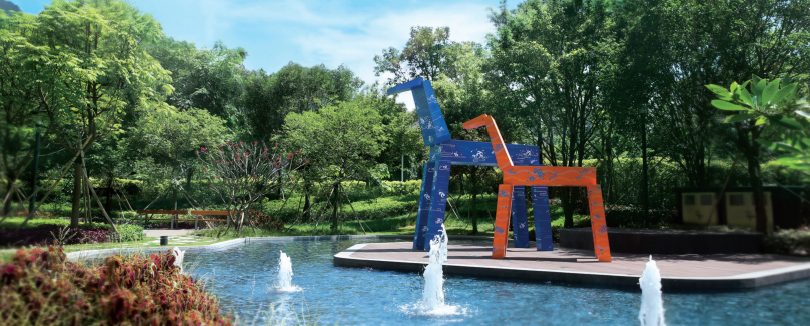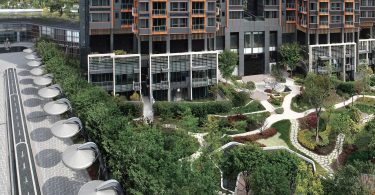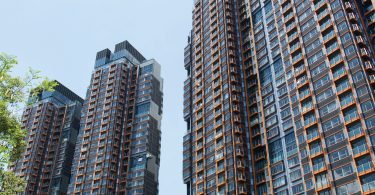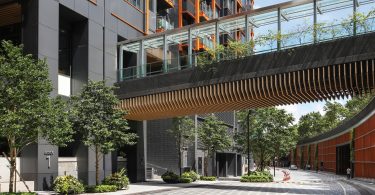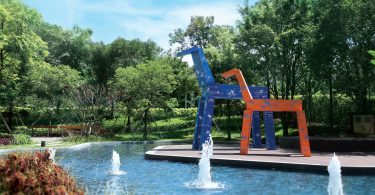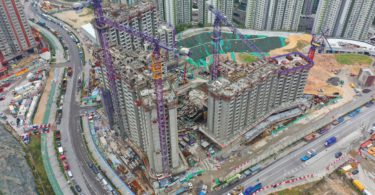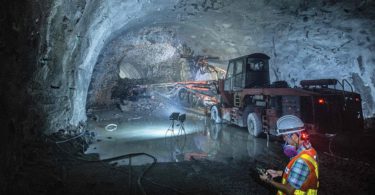VISION FOR A SUSTAINABLE LIVING COMMUNITY
Set in the suburban area of Lok Wo Sha near the Wu Kai Sha MTR station, the Double Cove development aims to set a high standard of promoting sustainable living within the development as well as for the neighbourhood. Its vision is to set a new benchmark for largescale residential developments.
With panoramic views of two bays and bordered by extensive woodland and coastline, Double Cove’s master plan features sustainable housing in 21 residential towers that range from 10 to 35 storeys in height.
SUSTAINABLE DESIGN CONCEPTS
The following concepts form the basis of the sustainable design for the Double Cove development: the concepts Living in the Park and Creating a Walkable Community were conceived by Lord Richard Rogers, a renowned British architect who was the design consultant for this project. The concept Happy Colour was used in the design of the building façade to create a visually stimulating building.
Situated in a natural twin-cove peninsula in Wu Kai Sha, the development’s residential towers are placed in a “stepped height” profile to enhance visibility and permeability for better views and natural ventilation. The typical floor plans of the towers were designed to maximise the view for each residential unit by providing either the bay or greenery view. Obstruction to views was minimised by creating visual corridors for the surrounding neighbours to enjoy.
MAKING THE SUSTAINABLE LIVING COMMUNITY A REALITY
Double Cove incorporates 3,500 residential units, as well as a shopping mall, clubhouse, kindergarten, car parks, landscaped gardens and a central park that acts as the precinct’s ‘green lung’.
LEED for Neighbourhood Development (LEEDND) guided the planning and design with ample green space—designated as a green area—covering 50 per cent of the site. Green roofs, walls and water features are scattered throughout the development to combat the urban heat island effect. The green area includes the existing woodland that is preserved (about 8,800 square metres) and the creation of an extension of the woodland area (about 16,000 square metres). In addition, green roofs, walls, water features and other landscaped amenity areas make up about 26,000 square metres to achieve a total planted area of 40 per cent of the site area. Native species were proposed for the landscaped areas as they are more adaptable to the local climate and environment, hence requiring less maintenance and less water for irrigation.
Recycled rainwater harvesting captures 1,700 cubic metres of water each year, saving around 70 per cent of the precinct’s drinking water. Waste recycling was considered, with food composting machines being one of the strategies encouraging residents to reduce, reuse and recycle. In addition, all residents receive a home automation system, helping them to manage energy consumption from a smartphone or iPad and make behavioural changes to reduce their carbon footprints.
The community facilities—including a sports hall; indoor and outdoor pools; 3D theatre and karaoke lounge; spa; and gymnasium—were designed with environmental efficiency in mind.
The design team was determined to create a walkable community with the residential towers arranged in pairs around a raised park, providing access to green spaces and community gathering places. The development promotes a healthy and active lifestyle by providing cycling tracks, jogging paths and a 24-hour, all-weather covered walkway with direct access to the MTR and public transport, which is connected to each residential tower through the shopping arcade. This allows residents as well as the surrounding neighbours outside the site to journey through the development and enjoy the greenery and retail amenities along the way, making their journey to and from the MTR convenient and pleasurable.
Communal bicycle rental is available to encourage cycling as a means of transportation, and the provision of electric vehicle parking spaces encourages residents to use electric vehicles. More than 80 electric vehicle charge stations, direct access to the MTR and communal bike rental encourage low-carbon transport options.
Advanced computer simulations were utilised to aid efforts to be more sustainable in design, including urban heat island analysis and building information modelling, which have enhanced efficiency and indoor environment quality, as well as reduced energy consumption by 15 per cent. Hybrid ventilation was adopted for the Shopping Arcade to reduce energy consumption.
Air quality was enhanced through these efforts and through the separation of buildings, as well as the installation of open entrances with high headroom for each pair of residential towers.
Double Cove has won a number of international awards for best high-rise development. Phase 1 has achieved Platinum BEAM accreditation, with provisional accreditation for other phases and Gold pre-certification under the LEED-ND rating tool. Double Cove shows how a high-rise can be highly sustainable.
Location: Lok Wo Sha, Ma On Shan, Hong Kong
Completion Date: December 2016
Site Area: 96,841 square metres
Gross Floor Area: 287,329 square metres (total gross floor area); 10,000 square metres (commercial area); 13,206 square metres (clubhouse area)
Number of units: 3,537 (residential units); 1,276 (car park lots)
Building Height: 18 – 35 storeys (above ground); 3 storeys (podium floors); 1 storey (basement)
Client/Owner: Harvest Development Limited
Design Consultant: Roger Stirk Harbour + Partners Limited
Architecture Firm: DLN
Principal Architect: DLN
Mechanical & Electrical Engineer: J. Roger Preston Limited
Civil & Structural Engineer: Stephen Cheng Consulting Engineers Limited
Main Contractors: Heng Shung Construction Co. Limited; Hip Hing Construction Co. Limited
Images/Photos: DLN

 Malaysia
Malaysia Singapore
Singapore Indonesia
Indonesia Tiếng Việt
Tiếng Việt ประเทศไทย
ประเทศไทย


